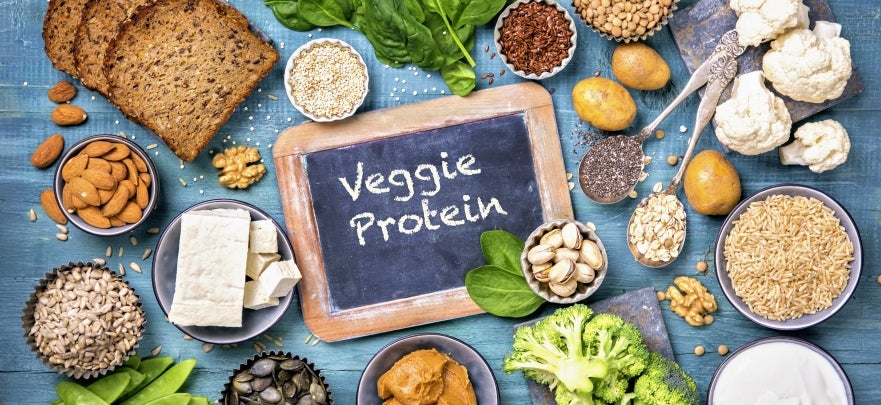How To Get Enough Protein Without Eating Meat
These days many people are going vegetarian for health or moral reasons. The common predicament discovered in this process is how to get enough protein on a plant-based diet. With the following tips, you can be sure to meet your protein requirements without the need for animal products.
To meet your body’s protein needs, you will have to strategize a nutrition plan to ensure that you get all the essential nutrients.
The Basics: Protein 101
Protein is a vital macronutrient. It is responsible for the repair and building of tissues such as muscle, ligaments, organs, skin, hair, and nails. It is also required for many cellular processes, building hormones, and neurotransmitters. Proteins are actually large molecules composed of smaller parts called amino acids.
Amino acids are the building blocks of muscles and serve as catalysts for almost every chemical process in the body. In total there are 20 amino acids. Nine of these are considered “essential” amino acids (EAA). In contrast to the other types of amino acids, EAAs are “essential” because the body can’t produce them on its own and can only get them from the diet. Most healthy humans can make the other amino acids they need.
When referring to getting enough protein, one must consider two things: the amount of protein and the right amount of all of the EAAs.
Complete vs. Incomplete Proteins
Every single food is made up of different combinations of amino acids and is characterized according to how much of each EAA they provide.
Foods that contain adequate amounts of all of nine EAAs are called complete proteins. Meat and other animal foods are considered “complete” sources because they have complete EAA profiles.
Foods that are missing one or more of the EAAs are called incomplete proteins. Most plant foods have incomplete protein profiles, which means that you must combine them with other plant foods that have different EAAs to make a complete protein meal. To complicate matters, the body isn’t always able to absorb all the protein we eat. The “bioavailability” (how much is actually absorbed and used by the body) of plant EAAs is lower than that of animal sources. If the label says there are 13 grams of protein in a veggie burger, it doesn’t mean that your body will actually be able to absorb and use all 13 grams.
Here is where strategic planning is involved. To meet your protein needs, you need to know which plant foods provide which EAAs and which can be combined to balance out the missing amino acids.
How Much Protein Do You Need?
The amount of protein you need per day depends on your age, gender, and activity level.
The current U.S. recommended dietary allowance (RDA) is 0.36 grams per pound of body weight per day (0.8 grams/kilogram). However, this estimate does not account for active people. Studies(1) suggest that 0.55 grams per pound of body weight per day (1.2 grams/kilograms) is the level from which most people can benefit.
To calculate your daily protein needs, multiply your body weight (in pounds) by .55. That’s about 82 grams per day for a 150-pound person.
Now that you know what your daily protein intake needs are, you can use these tips to meet them.
3 Ways to Get Protein on a Plant-Based Diet
1. Plants with Complete EAA Profiles The easiest way to get protein on a plant-based diet is to consume a variety of plants that have complete EAA profiles. The most popular and simple sources to include in your diet are:
-
Tofu (20 grams of protein per cup)
-
Quinoa (8 grams of protein per cup)
-
Hemp seeds (6 grams of protein per cup)
-
Buckwheat (6 g protein per cup)
2. Protein Combining
Another common way to ensure adequate protein intake is to combine two or more incomplete plant-protein sources whose EAA profiles complement each other. You don’t need to eat them all at the same time or even in the same meal; eat them over the course of a day and your body will take care of the rest.
Classic pairings include:
-
Beans and rice (7-15 grams of protein per cup, depending on the type of bean)
-
Whole grain bread with almond or peanut butter (about 10 grams of protein per slice)
-
Soups or stews that have legumes and grains (7-15 grams of protein per cup)
3. Supplements
Because plant proteins are harder to digest than animal sources, your body can only absorb and utilize a small amount of the EAAs they contain. One solution is to supplement your intake with plant-based protein supplements like Vegan Protein Powder blends, and vegan EAAs. But remember, unless the isolate is sourced from a plant like hemp or soy, it’s going to have an incomplete EAA profile. So, if you want to invest in a plant-based protein powder, make sure it’s a blend of complementary plant isolates that make a complete protein. Many companies make vegan protein blends that cover all the EAAs for you. For example, rice and pea protein blends are a good combination of EAA profiles.
Conclusion
There are plenty of options for getting more protein on a plant-based diet. Just remember that when talking about protein, we’re really talking about getting a balanced combination of EAAs that the body can absorb and digest.






